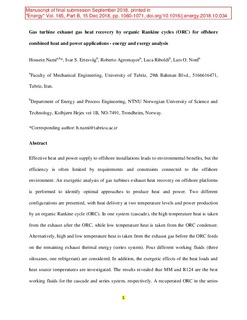| dc.contributor.author | Nami, Hossein | |
| dc.contributor.author | Ertesvåg, Ivar Ståle | |
| dc.contributor.author | Otero, Roberto Agromayor | |
| dc.contributor.author | Riboldi, Luca | |
| dc.contributor.author | Nord, Lars O. | |
| dc.date.accessioned | 2019-01-04T14:05:43Z | |
| dc.date.available | 2019-01-04T14:05:43Z | |
| dc.date.created | 2018-10-23T09:47:06Z | |
| dc.date.issued | 2018 | |
| dc.identifier.citation | Energy. 2018, 165 (Part B), 1060-1071. | nb_NO |
| dc.identifier.issn | 0360-5442 | |
| dc.identifier.uri | http://hdl.handle.net/11250/2579266 | |
| dc.description.abstract | Effective heat and power supply to offshore installations leads to environmental benefits, but the efficiency is often limited by requirements and constraints connected to the offshore environment. An exergetic analysis of gas turbines exhaust heat recovery on offshore platforms is performed to identify optimal approaches to produce heat and power. Two different configurations are presented, with heat delivery at two temperature levels and power production by an organic Rankine cycle (ORC). In one system (cascade), the high temperature heat is taken from the exhaust after the ORC, while low temperature heat is taken from the ORC condenser. Alternatively, high and low temperature heat is taken from the exhaust gas before the ORC feeds on the remaining exhaust thermal energy (series system). Four different working fluids (three siloxanes, one refrigerant) are considered. In addition, the exergetic effects of the heat loads and heat source temperatures are investigated. The results revealed that MM and R124 are the best working fluids for the cascade and series system, respectively. A recuperated ORC in the series system improve the siloxane results, with MM as the best working fluid. Moreover, decreasing the ORC minimum pressure in the series system makes considerable improvement. | nb_NO |
| dc.language.iso | eng | nb_NO |
| dc.publisher | Elsevier | nb_NO |
| dc.rights | Attribution-NonCommercial-NoDerivatives 4.0 Internasjonal | * |
| dc.rights.uri | http://creativecommons.org/licenses/by-nc-nd/4.0/deed.no | * |
| dc.title | Gas turbine exhaust gas heat recovery by organic Rankine cycles (ORC) for offshore combined heat and power applications - Energy and exergy analysis | nb_NO |
| dc.type | Journal article | nb_NO |
| dc.type | Peer reviewed | nb_NO |
| dc.description.version | acceptedVersion | nb_NO |
| dc.source.pagenumber | 1060-1071 | nb_NO |
| dc.source.volume | 165 | nb_NO |
| dc.source.journal | Energy | nb_NO |
| dc.source.issue | Part B | nb_NO |
| dc.identifier.doi | 10.1016/j.energy.2018.10.034 | |
| dc.identifier.cristin | 1622501 | |
| dc.description.localcode | © 2018. This is the authors’ accepted and refereed manuscript to the article. Locked until 10.10.2020 due to copyright restrictions. This manuscript version is made available under the CC-BY-NC-ND 4.0 license http://creativecommons.org/licenses/by-nc-nd/4.0/ | nb_NO |
| cristin.unitcode | 194,64,25,0 | |
| cristin.unitname | Institutt for energi- og prosessteknikk | |
| cristin.ispublished | true | |
| cristin.fulltext | postprint | |
| cristin.qualitycode | 2 | |

